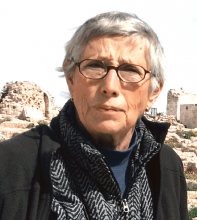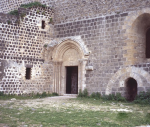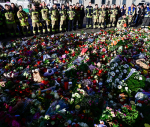You are here
False mantra
Apr 06,2022 - Last updated at Apr 06,2022
When dealing with the devastation wreaked by Russia on Ukraine during the ongoing war, Western military analysts point to the Russian air campaign in Syria. Indeed, for the "wise", "This is what the Russians did in Syria," has become a mantra. But this is a false mantra. Most destruction was caused not by Russian aerial bombing, but Syrian army artillery bombardments of areas held by militants and takfiris who fired into government-held residential areas in their campaign to overthrow the government whatever the cost to civilians.
However, such analysts and commentators do not have any idea of what happened in Syria or the Russian role in the war. Some of the iconic devastation took place well before Russia iintervened in 2015.
The first major flashpoint in the civil conflict was at Baba Amr, a suburb of Homs, Syria's third city, after the rebel Free Syrian Army (FSA) ambushed government troops and took control on February 3, 2012. The Syrian army responded with artillery bombardment of the city, which before the conflict had a population of 34,000, including a large disadvantaged and resentful Turkmen community that had been stirred up to fight the Syrian government. The Syrian army responded with artillery and rockets as hostilities intensified in and around Homs.
The Baba Amr battle became a media circus with foreign correspondents providing live coverage from a press centre, rather like the stream of news now flowing from Ukraine. The deaths of The Sunday Times' Marie Colvin and French photographer Remi Ocjlik and the woundings of two other journalists s on a strike on the media centre, created outrage in the world press. On March 1, the FSA withdrew, leaving the city in ruins and the survivors to fend for themselves.
While other FSA and takfiri-held Homs suburbs were systematically shelled and came under Syrian army control, fighters in the Old City held-out until May 2014. Some surviving militants surrendered, others were bussed to the sprawling township of Al Waer which was held by militants affiliated with Al Qaeda and FSA. I was in Homs to witness the fall of the Old City and subsequently toured it with a German colleague. Parts of the Old City were badly damaged, the suburbs, particularly Khaldiya, were devastated.
While the grand Arab city of Damascus was largely spared by the fighting, its suburbs witnessed destructive battles during 2014 and were subdued one-by-one. In mid-June, BBC correspondent Jeremy Bowen reported that President Bashar al-Assad had "never been in a better position since the war started three years ago".
In March 2015, I met UN and EU officials who predicted the war would be over by the end of the year. However, they did not know about the external provision of funds and weapons to takfiri factions which wrenched the north-western province of Idlib from government control. This offensive was a turning point which seriously challenged the Syrian army, its allies and the government. Russia, belatedly, deployed its air cover for the Syrian army at the end of September 2015, turning the tide of war in favour of Damascus.
The point I am making is that Russia was not involved in the Syrian civil conflict until then and cannot be held responsible for destruction inflicted on Syrian towns and cities by fighting between the army and militants who seized urban civilian areas and initiated hostilities by attacking troops and government targets. War is a terribly deadly and destructive business.
I have taken up the issue of the mantra because Russia was not the only outside power to have laid waste to Syria. Without external backers, the FSA and takfiri groups would not have posed a major threat to Syria's government and Daesh would never have taken over Raqqa and established its false caliphate in Syria and Iraq.
The US, belatedly, intervened in September 2014 after Daesh captured Mosul in Iraq. A week ago, the Rand Corporation, a major US think tank, issued a gently damning report on the US bombing of Raqqa which should amend the mantra to, "This is what the Russians and Americans did in Syria."
Summing up its findings, Rand said, "US strategic choices in the battle to liberate Raqqa, Syria, from [Daesh] in 2017 likely increased civilian harm despite considerable efforts to avoid civilian casualties by both US and coalition forces." Rand found that the US Defence Department "is not adequately organised or resourced to sufficiently assess, reduce and respond to civilian-harm incidents".
Why not? The answer is that the US military has always counted its own killed and wounded but not those of its antagonists and hapless civilians who became dehumanised “collateral damage”.
Aerial bombing was mainly responsible for the destruction inflicted on Raqqa, the summer capital of the Abbasid empire during Islam's Golden Age, and has left 60-80 per cent of the city "uninhabitable". The report "indicates that US strategic and operational decisions, such as the encirclement of Raqqa and insufficient shaping of the battlefield with replanned, carefully targeted air strikes prior to ground force engagements, made it more difficult to lessen civilian harm". Civilian casualties have been estimated by Rand at 774 while other sources put the figure at 1,600 and Kurdish forces said they collected 4,000 bodies from the rubble.
Rand stated, "After the battle, flawed [Defence Department] processes and poor collection and analysis of civilian casualty data hindered the military's ability to adequately assess the full scope of civilian harm. The large amount of structural damage to Raqqa and, subsequently, inadequate US planning or support for its reconstruction also undermined post-battle governing prospects and long-term US interests."
Readers of this article must take into account that the language used by Rand is polite, as the report was commissioned by the Defence Departmentt which has promised to reform and rectify practices that are illegal under international law which forbids attacks on civilians and "civilian objects" but is all too often ignored by state armies and non-state armed factions.












